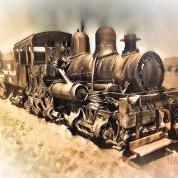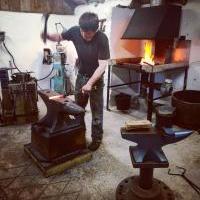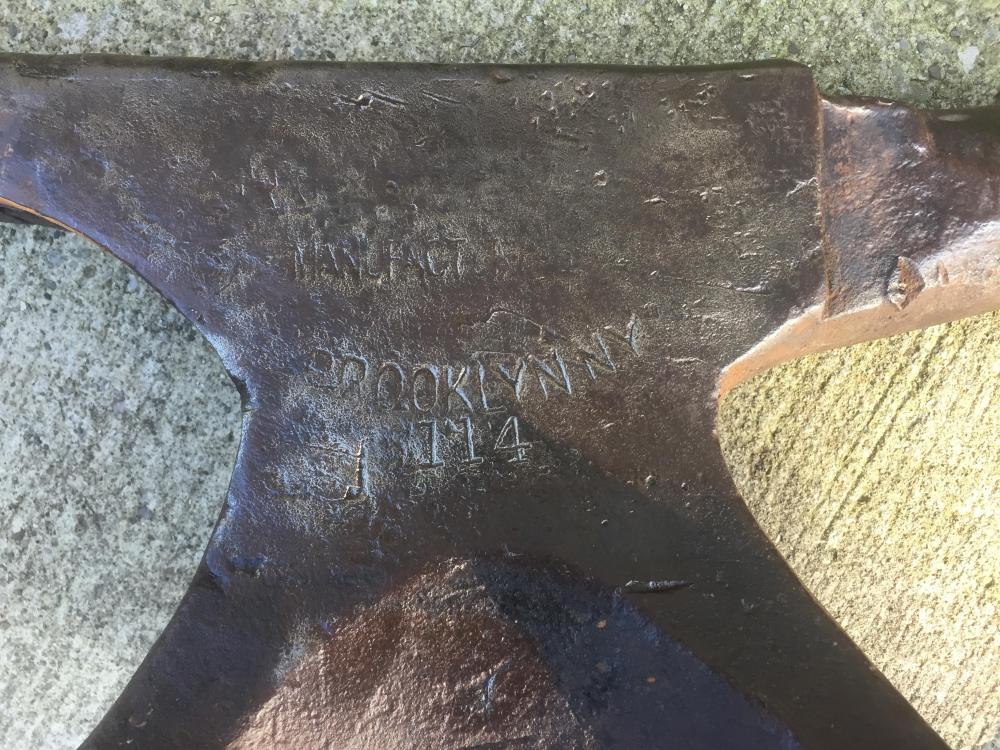
G-ManBart
Members-
Posts
115 -
Joined
-
Last visited
Profile Information
-
Gender
Male
-
Location
Detroit
Recent Profile Visitors
-
There was no company named Trenton that made anvils. Columbus Forge and Iron made anvils marked with "Trenton" as their house brand. They also made them that were marked ACME, AJAX, and others. Hay-Budden also made anvils marked ACME.
-
My first real Anvil - opinions please
G-ManBart replied to GrumpyBiker's topic in Anvils, Swage Blocks, and Mandrels
GB sent me a note...the serial number listed was different than the picture. AIA says 1922-23 for the actual serial number in case anybody was wondering. -
My first real Anvil - opinions please
G-ManBart replied to GrumpyBiker's topic in Anvils, Swage Blocks, and Mandrels
AIA says 1918. -
I have a small 114# early Hay-Budden with a base that looks identical to yours. Mine has a 4-digit serial number which dates to 1913 (2nd year or production) and has plenty of the factory markings on the side to positively identify it. I've had one other early H-B with a similar base, but can't recall if I have any pictures of it or not. Sorry the pics aren't great...just took them before I headed to the house to pull out AIA and check the serial number.
-
Experience with Blacksmiths Paradise?
G-ManBart replied to bajajoaquin's topic in Anvils, Swage Blocks, and Mandrels
Emerald is a bit difficult to work with (I bought two anvils from him). We had a long back and forth over several months and I told him I wanted to buy three vises to fill a pallet (1,000lbs). All along, I was up front and said it might take me a few months to decide on anvils, and have the money at the same time, and he said he was fine with holding onto them until they could ship at the same time. I bought one anvil, then a month or so later bought another. I was trying to decide on a third, but never got to that. Oh, he won't take anything but a wire transfer if you buy outside of eBay, so add $25 or so to the cost. Without any notification I got a call from a guy named Henry in Texas saying that he had my anvils and wanted to know how I wanted to deal with shipping them. Needless to say, I was pretty annoyed. Emerald never checked with me before shipping because he prefers to send a container to Texas with everyone's anvils, give that guy a free anvil (or one very heavily discounted) and let him deal with re-shipping them to all of the other buyers. In the end I wound up paying Emerald for shipping to Texas, then setting up my own shipping from Texas to Michigan. To make things even more interesting, a local friend of mine had also bought an anvil from Emerald at the same time, and it turns out he didn't pay anything for the shipping between Germany and Texas. He and I combined our three anvils and got them shipped from Texas to Michigan fairly reasonably, but it was still not what I ever intended since Emerald lists he can ship to most any major U.S. city and all of the Detroit freight places are within about 20 minutes of my house. Henry was very helpful, combined the two shipments into one, and got them dropped off at the freight terminal for me. He told me that a number or people he called had the exact same response and had no idea their anvils were going to get shipped to Texas. I will say that both of the anvils I bought, and the one my friend bought, were exactly as the pictures described. All of this comes down to communication. If Emerald had been up front and said "I ship X times a year, and send them all to Texas, and then you'll coordinate with Henry" or something like that, I would have been okay with it, but having it dumped on me like this was unprofessional, especially since he knew I was looking to buy three anvils, not just two. There are no import taxes on anvils, or other blacksmithing items. -
Soderfos stamp meanings
G-ManBart replied to Jclonts82's topic in Anvils, Swage Blocks, and Mandrels
That makes sense...could be something else entirely as well. Is there any documentation or idea when they changed to the newer stamp style? I have it mounted on a nice fabricated steel stand and my search for the perfect smaller anvil is probably over. -
Soderfos stamp meanings
G-ManBart replied to Jclonts82's topic in Anvils, Swage Blocks, and Mandrels
My Soderfors has a number that could well be a serial number....can't see how it could possibly be a date. Everyone who sees this beauty tries to buy it, but she's mine, mine, mine all mine. -
Black Prince Anvil. Shapleigh hardware
G-ManBart replied to Billytr11's topic in Anvils, Swage Blocks, and Mandrels
Technically, your anvil isn't a "Trenton". Columbus Forge and Iron made anvils with many names on them, with Trenton being the name they sold as their own brand. When they made them for others they had a variety of names stamped on the side. Assuming Anvils in America is correct, CFI only made around 300 anvils for Shapleigh Hardware Co....so it's definitely unusual and a great find! Unfortunately, some folks always seem to semi-scold someone for asking if their newly found anvil is rare, or how old it is, or how many were made. You just have to ignore that. -
Hay budden identification
G-ManBart replied to Shagwagon's topic in Anvils, Swage Blocks, and Mandrels
No need...I've got thick skin -
Hay budden identification
G-ManBart replied to Shagwagon's topic in Anvils, Swage Blocks, and Mandrels
Fair enough. I opened the first picture up to it's full size, and it looked like the one chip at the front, and one near the back had sharp edges on the top side, but it could just be the lighting since metal isn't easy to get good pictures of. Obviously, running a finger over them would be worth lots of pictures -
Hay budden identification
G-ManBart replied to Shagwagon's topic in Anvils, Swage Blocks, and Mandrels
I'm not asking to start an argument...just an honest question. You wouldn't lightly dress the sharp edges on some of those chips so they don't get worse? -
Hay budden identification
G-ManBart replied to Shagwagon's topic in Anvils, Swage Blocks, and Mandrels
I recall there were changes over time in the number of handling holes, with some variation based upon weight, as well as the shape of the depression in the base. Pictures of the base along with pictures of any handling holes might help as well. You sure picked a good one to find first! -
It depends on the brand/model and how the spindle is retained. The majority of vises use a set collar of some kind on the inside of the dynamic jaw to retain the spindle. You take the dynamic jaw out, flip it over, and there will be an obvious set collar. Wear to either the back of the spindle, or the set collar, creates a gap you have to take up by turning the handle. With the dynamic jaw out of the body you'll be able to push/pull on the spindle and see the slop. You can usually add a thrust washer in front of the set collar to tighten things up, or rotate the position of the set collar, and drill a new hole in the spindle for the set screw. I generally just add a thrust washer, but yesterday moved the hole for the set collar on an old Reed because the hole for the set screw was worn oblong. It can also be a loose nut in the body of the vise. Most are held in place with a pin and if the pin isn't a tight fit to the nut, when you turn the handle, the nut moves back and forth. Normally you can just bend the pin forward until it's making contact with the nut and you're set. I usually heat the pins and pre-bend them close to what they need to be rather than install them in the vise and hammer on them....all of the load is being taking by the casting of the base, and that's a bad idea. If the vise is a Reed with a split ring in front and adjustable nut stop in the rear it's a different issue...usually just an adjustment.
-
I just ordered a Diamondback 2-burner blacksmith model over the weekend after reading lots of threads like this, and a number of reviews, and YouTube videos. I'm really looking forward to it. I might be able to help with the post vise and anvil...I seem to have a knack for finding them. I'll send you a PM.
-
The range is pretty broad depending upon brand, model and condition. For example, the 6" Reed swivel jaw I'm hoping to get a shot at eventually would be an easy $500 in many places and higher in some where vises are scarce. If it were an 8" Reed swivel jaw that number easily doubles. I have a buddy who has a 7" Yost swivel jaw he would sell for $750, and it could really do with having a new set of jaws custom made for it. Up through 6" models it's pretty easy to price the, but any bigger they're fairly rare and the folks buying them don't necessarily like to share what they pay for them. I nearly stole that 8" American Scale for $350, and AS is on the lower end of quality and desirability.


